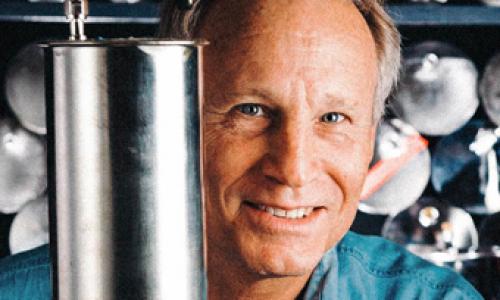
Professor Blake brings state-of-the-art techniques for measuring trace gases in air and in human breath to the ORU. Atmospheric composition is changing at an unprecedented rate. His research group identifies and quantifies atmospheric gases in (a) remote locations throughout the Pacific region from Alaska to New Zealand: (b) highly polluted cities throughout the world; and (c) areas with special conditions, such as burning forests and/or agricultural wastes, or the marine boundary layer in oceanic locations with high biological emissions. Whole air samples are collected on land, ships, and aircraft and are returned to his laboratory for analysis.
Gas chromatography utilizing flame ionization detection, electron capture detection, and mass spectrometry is the main analytical tool. A three-gas chromatograph analytical system is used to quantify about 150 halocarbons, nonmethane hydrocarbons, and alkyl nitrates ranging in mole fraction from about 2 parts per billion to 10 parts per quadrillion.
In an attempt to determine "background" concentrations of selected trace gases, since 1978 he and his team have been collecting air samples at surface locations every three months in Pacific regions from northern Alaska to southern New Zealand. Results from this "background" study recently led to their discovery that methyl bromide, a gas that significantly affects stratospheric ozone concentrations, has a tropospheric seasonal cycle. This finding provides an important constraint on hemispheric and seasonal methyl bromide sources and removal processes.
Energy use, principally fossil fuel combustion, in eastern Asia has increased substantially during the past decade and likely will continue into the next decade. Concentration data for samples collected in various Chinese cities and rural areas by group members and colleagues from Hong Kong and Guangzhou will be used to help better constrain emission inventories used in chemical models of the atmosphere.
Since 1988 his research group has been involved in NASA- and NSF-sponsored airborne projects. The general motivation for these experiments is regional or global change. For example, the 1991 and 1994 NASA Pacific Exploratory Missions-west (PEM-west) were designed in part to determine baseline concentrations of trace gases and aerosols in air advected from the Asian continent.
NASA’s 2001 TRACE-P airborne mission flown in the same region and season (winter/spring) as the 1994 PEM and provided valuable information regarding changes in atmospheric concentrations of important trace gases. The Japanese Space Agency missions (PEACE) flown in winter and spring of 2002 were in part designed to extend the seasonal observations of the TRACE-P project. In 2004 and 2006 the group flew on NASA’s INTEX missions that were designed to study chemistry and transport of pollutants from mega cities. NSF also funded the 2006 Mexico City airborne study. In 2007 the group flew on NASA’s TC4 mission in which upwelling of tropical air into the upper troposphere/lower stratosphere was studied. In 2008 the group flew on the NASA DC-8 aircraft for a polar mission in which boreal forest fire emissions and Arctic haze were studied.Group Website
Ph.D., University of California, Irvine, 1984
M.S., University of California, Irvine, 1980
B.S., University of California, Los Angeles, 1978
